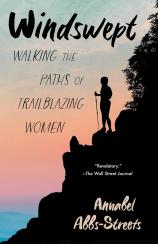Windswept: Walking the Paths of Trailblazing Women
Review
Windswept: Walking the Paths of Trailblazing Women
It isn’t until the very end of WINDSWEPT --- in her Acknowledgments, actually --- that UK writer Annabel Abbs references the onset of COVID-19 and its impact on the final trek in her ambitious project to physically trace the routes of eight extraordinary walking women of the 19th and 20th centuries.
Yet there could be no better mental and muscular challenge to the inertia, apathy and sedentary despair that so many of us have experienced as this global pandemic stretches into its second full year. Health experts and social scientists have seen a hopeful rise in solo walking as an intentional activity with demonstrable benefits for both psychological and physical health and few, if any, social distancing limitations. Abbs also points out the bodily demands (sometimes overwhelming) and benefits (sometimes surprising) of experiencing other women’s lives through her feet. But the real journey began in her head.
Like the iconic American social historian and intrepid walker Rebecca Solnit, whose writings on her own foot journeys helped fuel her determination to put a female stamp on the oldest form of human locomotion, Abbs found herself increasingly frustrated by the near-invisibility of women who walked not only out of necessity, but on purpose.
"...one of the most exhilarating and masterful reflections ever on how to meaningfully move on our own feet and the remarkable women who made this a unique expression of their being."
With her children all nearing adulthood and faced with the prospect of being an “empty nester,” Abbs became emotionally and intellectually invested in understanding the inner drive of eight famous and lesser-known women who chose walking in order to experience a universe beyond motherhood and homemaking --- Frieda von Richthofen, Gwen John, Clara Vyvyan, Daphne du Maurier, Nan Shepherd, Simone de Beauvoir, Emma Gatewood and Georgia O’Keefe.
Raised in rural Wales by parents who for years disdained car ownership and other “mod cons,” Abbs had walking ingrained in her almost from the time she could stand on her own. As she grew up, went away to school, worked, married, raised a family and achieved success as an award-winning journalist, magazine writer and novelist, walking as a pursuit in and of itself receded into the background. Her epiphany happened as she recovered from a serious fall and head injury; she again would take up long-distance walking as a personal passion and involve her family as well.
While her partner and children were supportive, if not always as enthusiastic on the ground, Abbs soldiered on, building stamina and endurance. But more importantly, she steadily deepened her inner knowledge of how other women used their feet to nurture and expand their identities.
After reading numerous hiking, trekking and walking memoirs nearly all by men, she gathered this small but powerful group of female writers, artists, teachers, poets and philosophers, all of whom left scattered paper trails of their personal journeys. Over years of painstaking research, including getting access to documents never before published, Abbs focused her efforts on bringing their journeys to light in WINDSWEPT.
She simply could have created a series of thumbnail biographies around their little-known (or totally unknown) walking escapades, but the project became much more personal than that. Abbs resolved to follow, as best she could, some of the main rural and urban routes each of these eight women had travelled and reflect on them as more than mere historical events.
And she would do so with the bare minimum of equipment and supplies, just as they had done in previous centuries. That in itself was a big ask for someone used to 21st-century high-tech outdoor clothing and electronic GPS gadgetry. It would not be a 100% “pure” historical re-creation, but she never short-changed the actual walking, even when time had erased many of the landmarks her historical mentors would have known.
Travelling, often alone, through Britain, southern Europe and the harsh desert landscapes of the southwestern United States, Abbs noticed a fascinating intersection of her precursors’ experiences with 21st-century realities. Then and now, there was gratification, fear, wonder, relief, fatigue, exhilaration, despair and fulfilment. She notes emphatically that men who write walking memoirs never mention fear; women, she surmises, are the braver for doing so.
Especially compelling about the book’s prose is its clarity and frankness about the vulnerability of the unaccompanied female body on foot. Abbs doesn’t shy away from commenting on the same challenges faced by her historic walking mentors, who had to deal with menstruation, relieving themselves, finding safe places to sleep, or avoiding predatory male attention. None were postmenopausal when they undertook their legendary journeys.
If I could be allowed one “nitpick” in WINDSWEPT, it’s the book’s total lack of maps or pictures of the women and places Abbs writes about. But as a timely inspiration for all of us to get off the couch and walk --- somewhere, anywhere --- just for the sake of it, it’s one of the most exhilarating and masterful reflections ever on how to meaningfully move on our own feet and the remarkable women who made this a unique expression of their being.
Reviewed by Pauline Finch on October 1, 2021
Windswept: Walking the Paths of Trailblazing Women
- Publication Date: February 18, 2025
- Genres: History, Memoir, Nonfiction, Travel
- Paperback: 384 pages
- Publisher: Tin House Books
- ISBN-10: 1963108132
- ISBN-13: 9781963108132




